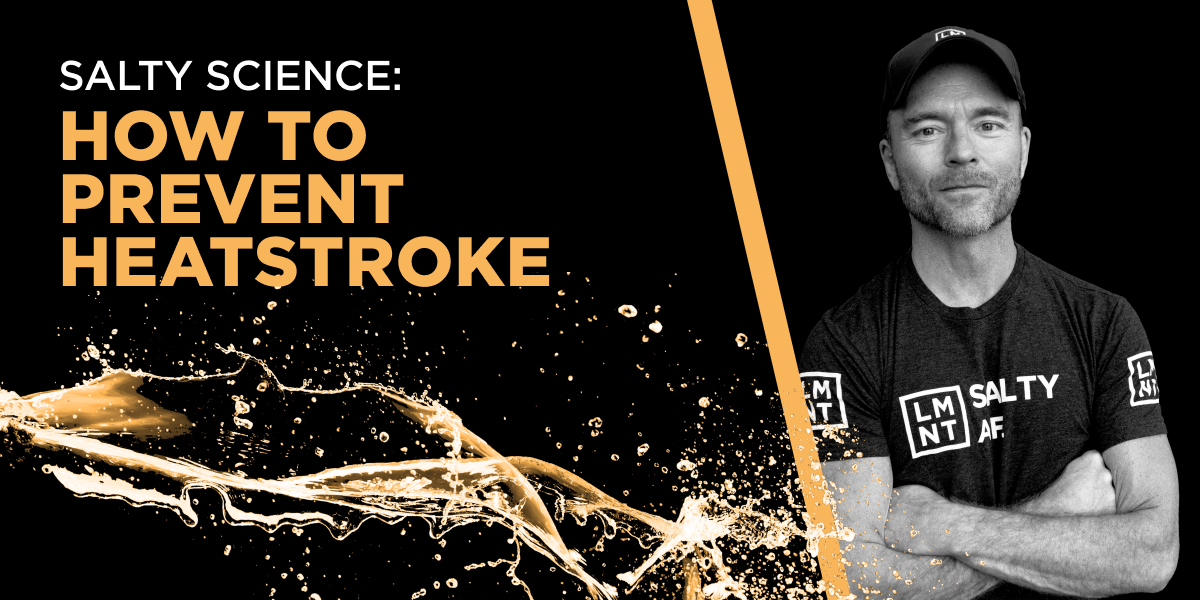Heat illness ranges in severity. Heatstroke, when temperatures overwhelm the body’s self-cooling mechanisms, is at the most dangerous end of this spectrum. Heatstroke symptoms can include confusion, delirium, and even seizures because elevated body temperatures affect the central nervous system.
Once a person reaches heatstroke, it can be difficult to reverse this life-threatening condition. And so, to save lives, it’s crucial to prevent heat stress from progressing.
The good news is that heatstroke doesn’t occur suddenly. A progression of heat stress symptoms serve to warn you to get indoors, rest, and rehydrate with fluids and electrolytes. Prevention is mostly common sense, but confusion often arises around hydration.
Hydration? That’s simple! Just chug lots of water before, during, and after exercise, right?
Actually, no. Drinking too much plain water can actually worsen heat illness by diluting blood sodium levels. You need water AND electrolytes—especially sodium—to replace fluids and critical minerals lost through sweat.
In this article, you’ll learn the basics of heatstroke, its causes, what typically precedes it, and a few tips for prevention. Let’s keep rolling, shall we?
Heatstroke Symptoms
Heatstroke is the most serious type of heat-related illness. How serious? According to published data, classic heatstroke (not due to exercise) has a 10-65% mortality rate. That’s why hot weather is the leading cause of weather-related deaths in the US, ahead of floods, rip currents, tornadoes, hurricanes, and extreme cold.
Older populations are disproportionately affected by heatstroke because they can have more difficulty regulating core body temperature due to an impaired sweat mechanism, among other physiological reasons.
Excluding fever, thermoregulatory mechanisms like sweat are usually able to keep body temperature between 97.7 and 99.5℉. But in cases of heatstroke, body temperature can often exceed 104℉—hot enough to cause organ damage, nervous system dysfunction, and other undesirable results.
Symptoms of heatstroke include:
- Hot, dry skin due to lack of sweating (anhidrosis)
- Rapid heartbeat (tachycardia)
- Rapid breathing (tachypnea)
- Low blood pressure
- Weakness
- Lethargy
- Nausea
- Vomiting
- Dizziness
- Flushing
- Lung crackles
- Low urine output
- Bleeding (potential evidence of hemorrhagic complications)
- Neurological symptoms (confusion, difficulty speaking, delirium, seizures)
Additionally, heatstroke patients may incur organ and muscle damage. Because of this, doctors will often run tests to examine kidney and liver function, and monitor levels of creatine kinase, a critical blood protein, for muscle injury.
Serious business. But thankfully, we can be proactive in our prevention measures to avoid heatstroke altogether. Let’s talk about heat exhaustion now to keep you a step ahead of heatstroke.
Heatstroke vs. Heat Exhaustion
Before someone experiences heatstroke, they encounter heat exhaustion. Heat exhaustion, sometimes called heat stress, is an umbrella term for when core body temperature rises above the normal range, but not to a point of causing physical injury.
Symptoms may include excessive sweating, tiredness, nausea, dizziness, vomiting, headache, and heat-related muscle cramps. The symptoms may be uncomfortable, but once treated, heat exhaustion usually resolves without complications. The important thing is to take action before it progresses to heatstroke.
To be clear, this doesn’t mean we should always avoid significant heat. In some cases, minor heat stress can actually have health benefits. Take the data on saunas, for example. Controlled exposure to high heat—say, 20 minutes at 170℉—has been shown to improve circulation, growth hormone levels, and neural health. And Finnish data suggests that regular sauna users tend to experience less heart disease, Alzheimer’s, and all-cause mortality. Not to mention all the groovy sauna hats. (Google it. You’re welcome.)
So heat can be healthy, but not too much of it. Next up: heatstroke risk factors.
Heatstroke Risk Factors
We already covered that heatstroke results when the body can’t cool itself effectively. Now we’ll elaborate on contributing factors: weather, age, exercise, and more.
Preventing heat iIlness should be top-of-mind as temperatures approach 90℉. High humidity, lack of breeze, and direct sunlight can also amplify the effects of hot weather. Perhaps keep your favorite weather app’s notifications on to stay in-the-know when heat alerts are issued for your area.
There are two main categories of heatstroke:
- Classic heatstroke
- Exertional heatstroke
Classic heatstroke primarily affects older people. They are more likely to have other health factors which increase the difficulty of regulating their body temperature. That’s why classic heatstroke has a greater mortality rate than exertional heatstroke.
Exertional heatstroke is typically a problem for young people who overdo exercise in hot or humid conditions. The mortality rate is lower, between 3 and 5%, mostly because this group is better-equipped to deal with heat-related iIlness. With quick and proper treatment, young people rarely die from heatstroke.
Beyond age, climate, and exercise, other factors that increase the risk of heatstroke include:
- Medications. Many drugs (anti-inflammatories, beta-blockers, etc.) decrease heat tolerance.
- Impaired sweat mechanisms. Older folks often have impaired sweat mechanisms, but younger folks can too.
- Alcohol. Alcohol consumption can cause heat intolerance.
- Clothing. Are you dressed in a cotton t-shirt or a ghillie suit?
- Hydration. Being dehydrated or short on electrolytes amplifies heat illness symptoms.
- Other conditions. Heart disease, diabetes, skin infections, and other conditions can impair thermoregulation.
Now that you’ve learned what contributes to heatstroke, let’s cover how to prevent it.
Preventing Heatstroke
To avoid heatstroke, use common sense and listen to your body: stay out of the heat, don’t overexert yourself, and stay hydrated.
Stay out of the heat
I’m not saying you should cower in a dark, chilly basement watching Netflix all day when it’s hot outside. You can minimize your time in the heat and stay active too. Just keep tabs on the weather and consider moving your workout inside: at home, or in an air-conditioned gym.
On that topic, ensure that your and those in your care have access to functioning A/C before a heat wave hits. Fans and cooling misters help too, but there’s no substitute for air conditioning.
Don’t overexert
If you have to be outside during a heat wave, modify your activities. The 110℉ day is not the time to push for your marathon personal record or take grandpa golfing. Reduce your physical efforts, and make good choices like working out in the shade or at a cooler time of day.
Stay hydrated
Sweat is your primary cooling mechanism on hot days. As the days get hotter and more humid, you’ll perspire more, leading to greater fluid and sodium losses. If you don’t replace what’s lost, you end up dehydrated or with low sodium levels.
What’s worse, with all of the “drink more water!” hooplah we hear in the media, folks often overconsume plain water, diluting their blood sodium levels. It’s a primary factor in exercise-associated hyponatremia, a dangerous condition of low serum sodium.
The key is to consume enough water and sodium to quench your thirst, and no more. Drinking to thirst prevents dehydration, and including electrolytes—especially sodium—prevents symptoms like cramps, fatigue, brain fog, and headaches. (An important aside: seniors are prone to broken thirst mechanisms. Sipping electrolyte drinks on a set schedule can help compensate.)
LMNT is excellent for hydration. It’s our zero-sugar electrolyte drink mix with a science-backed ratio of electrolytes: 1000 mg sodium, 200 mg potassium, and 60 mg magnesium. It really is a game changer, but you needn’t take my word for it—you can actually feel it working.
Treating Heatstroke
If you suspect that someone has heatstroke, call 911 immediately. Heatstroke is a severe condition that requires urgent medical care. While you wait for help to arrive, carefully get the person into nearby shade or air conditioning. If transport isn’t possible, ideally bring the person ice packs or cool towels. After medical staff handle the ABCs (airways, breathing, and circulation), their attention will also turn to cooling the patient.
Fluid and electrolyte imbalances are common in hospitalized heatstroke patients, but it can be difficult to determine whether the person has reached the point of hypernatremia or hyponatremia. They may be dehydrated (often with high sodium levels) or overhydrated (often with low sodium levels), and these determinations are best made and treated by medical professionals, which is why our best bet is prevention.
Sip electrolyte water to thirst. Stay cool. Stay hydrated. Stay Salty. ⚡

